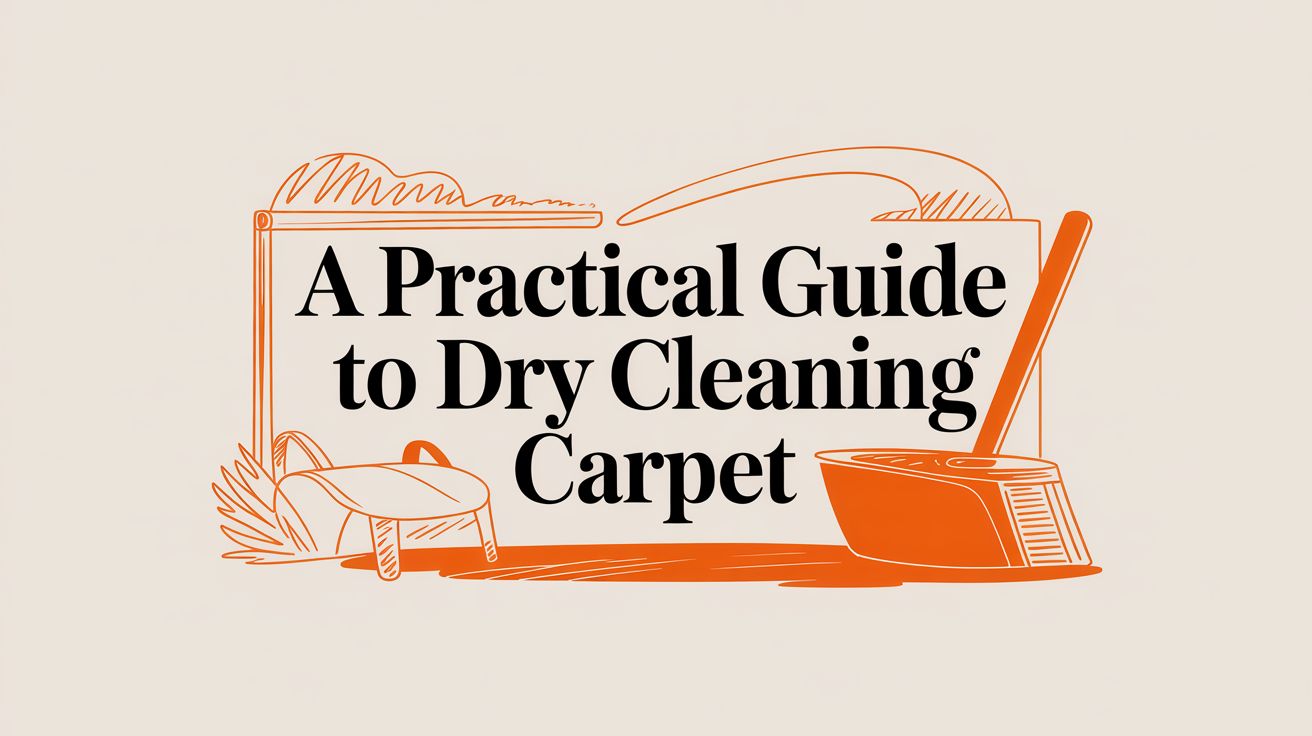Tired of soggy carpets and that lingering damp, musty smell? Let’s talk about a smarter way to clean. Dry carpet cleaning is a low-moisture method that gets deep into the fibers to pull out dirt, oils, and allergens—all without soaking your floors. It's the perfect solution for busy households that can't afford hours of downtime. You get your living space back almost immediately.
Why Dry Cleaning Your Carpet Makes Sense
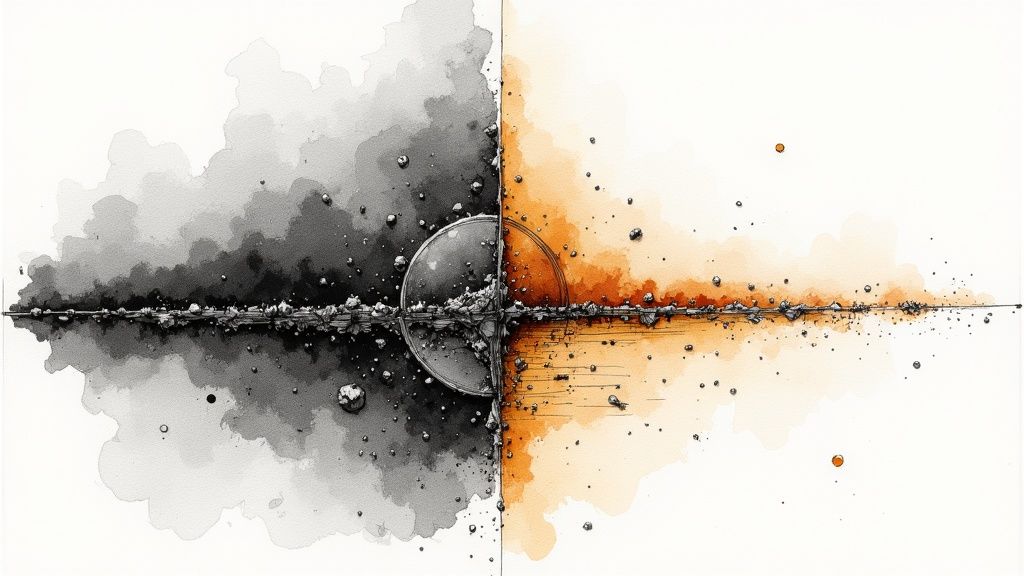
We've all seen what happens with traditional wet cleaning. They pump gallons of water into your carpet, which often leads to ridiculously long drying times. Worse, that excess moisture can create a breeding ground for mold or even damage the carpet fibers themselves. This is exactly where the dry cleaning method, or what we in the industry call Very-Low-Moisture (VLM) cleaning, really shines.
Instead of flooding your carpet and its backing, this approach uses specialized absorbent compounds or highly concentrated VLM solutions. Think of it this way: these cleaning agents are designed to latch onto grime and dirt, encapsulating it so it can be lifted away with powerful, specialized vacuums. The result? A truly deep clean without the soggy mess.
The Benefits of a Low-Moisture Approach
One of the biggest wins here is the incredibly fast drying time. Most carpets are ready for you to walk on in just one to two hours. Compare that to the 24-hour (or longer!) wait you get with old-school steam cleaning. That quick turnaround is a lifesaver for families with kids, pets, or anyone who just wants their home back to normal.
This method is also much kinder to delicate carpet fibers. If you have natural materials like wool or sisal, you know they can shrink or discolor when they get too wet. Dry cleaning seriously reduces that risk, helping preserve the look and feel of your carpet for the long haul.
It's a big deal. The demand for carpet cleaning methods that actually protect the carpet is growing fast. In fact, the global carpet cleaner market is expected to hit over USD 1.1 billion by 2033, largely because people are tired of methods that cause unnecessary wear and tear.
But the perks don't stop there. By using way less water, dry cleaning also:
- Prevents Mold and Mildew: Less moisture means you're not creating the damp, dark environment where mold loves to grow.
- Improves Indoor Air Quality: The process effectively pulls out trapped allergens and dust without pumping a ton of humidity back into your air.
- Avoids Sticky Residue: Many dry methods skip the heavy soaps and detergents that can leave behind a sticky film that just attracts more dirt later on.
To help you see the difference clearly, here’s a quick breakdown of how dry and wet methods stack up against each other.
Dry Cleaning vs Wet Cleaning At a Glance
| Feature | Dry Carpet Cleaning | Wet Carpet Cleaning |
|---|---|---|
| Drying Time | 1-2 hours | 6-24+ hours |
| Water Usage | Very low | Very high |
| Risk of Mold/Mildew | Minimal | Higher risk |
| Residue | Typically none | Can leave sticky, soapy residue |
| Fiber Safety | Gentle on most fibers, including natural ones | Can damage delicate fibers like wool |
Ultimately, the choice comes down to what you value most—speed, safety for your carpet, or just avoiding a swampy living room.
If you're still weighing the options, knowing the nitty-gritty details can make all the difference. We put together a detailed comparison of VLM versus truck-mount steam cleaning that breaks down which method is truly best for your home.
Look, you can't just jump straight into dry cleaning carpet without doing the prep work first. That’s like trying to paint a wall without dusting it—you’re just sealing the dirt right in. The real success of any deep clean starts long before you even open a cleaning product.
A proper prep job is way more than just a quick once-over with the vacuum. Your carpet fibers are basically tiny traps for all the dust, pet hair, and crumbs that life throws at them. To get a truly deep clean, you have to get as much of that loose gunk out as possible. This lets the cleaning compound get right to work on the embedded oils and grime, which is what you're really after.
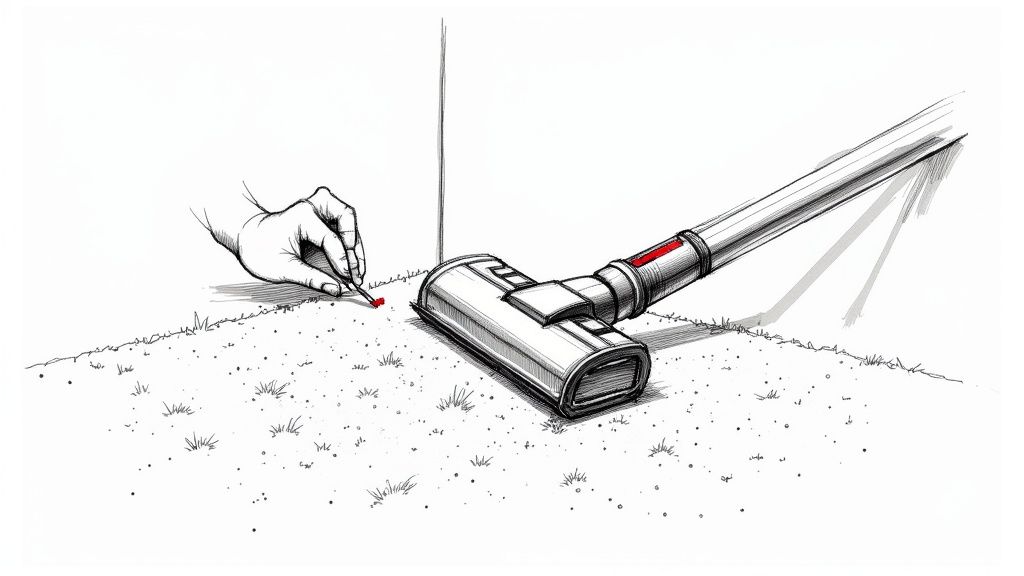
Start by vacuuming the entire room, but do it slowly and in overlapping rows. Don't rush it. Then, grab your vacuum's crevice tool and get right up against the baseboards. It's shocking how much dust collects there. For those high-traffic areas where the carpet looks flat and matted down, use a brush attachment first to agitate the fibers. This loosens up all that compacted dirt, making it way easier for the vacuum to suck it up.
Know Your Carpet Material
Not all carpets are made the same, and I can tell you from experience that using the wrong product is a fast way to ruin a perfectly good floor. Figuring out what your carpet is made of isn't just a suggestion; it's a must-do step.
Most carpets in homes today fall into a few categories, and each one has its own quirks.
- Nylon and Polyester: These are the workhorses. They're synthetic, tough, and can handle most dry cleaning powders without any issues.
- Wool: This is a natural fiber. It looks great but it's a bit sensitive. High-alkaline cleaners or too much moisture can damage it, which actually makes a low-moisture dry cleaning method a fantastic option.
- Sisal or Jute: These are plant-based fibers, and they act like sponges. Get them too wet, and they can stain or even warp. For these, a dry method is pretty much the only safe way to go.
If you have no idea what you're working with, check for a manufacturer's tag on a leftover piece of carpet, maybe in a closet or the attic. No tag? You can do a little detective work. Snip a single fiber from a spot no one will ever see (like deep inside a closet). Hold it with tweezers and carefully bring it near a flame—do this over a sink, please! Synthetics will melt into a hard little bead. Wool, on the other hand, will just char and smell like burnt hair.
Pro Tip: Even if you're 100% sure you know your carpet type, always do a spot test. Always. Find an inconspicuous area, like under the sofa or in a closet, and apply a small amount of the dry cleaning compound. Follow the directions, wait the recommended time, vacuum it up, and then check for any color bleeding or changes in texture. This one simple check can save you from a massive headache later.
The Complete Dry Cleaning Process at Home
Now that your carpet is prepped and ready, it's time for the main event. You'll be happy to know that at-home dry cleaning is surprisingly straightforward. It really just boils down to a simple "sprinkle and brush" technique.
This isn't about scrubbing until your arms are sore. It's about letting the cleaning compound do the heavy lifting.
The secret sauce here is the dry cleaning powder itself. This isn't just some scented dust you're throwing on the floor. It’s made of tons of tiny, sponge-like particles engineered to grab onto oils, dirt, and allergens. When you sprinkle it on, these particles act like little magnets, pulling all that gunk out of the carpet fibers without soaking them in water.
This infographic breaks down the simple, three-stage flow of a home dry carpet cleaning session.
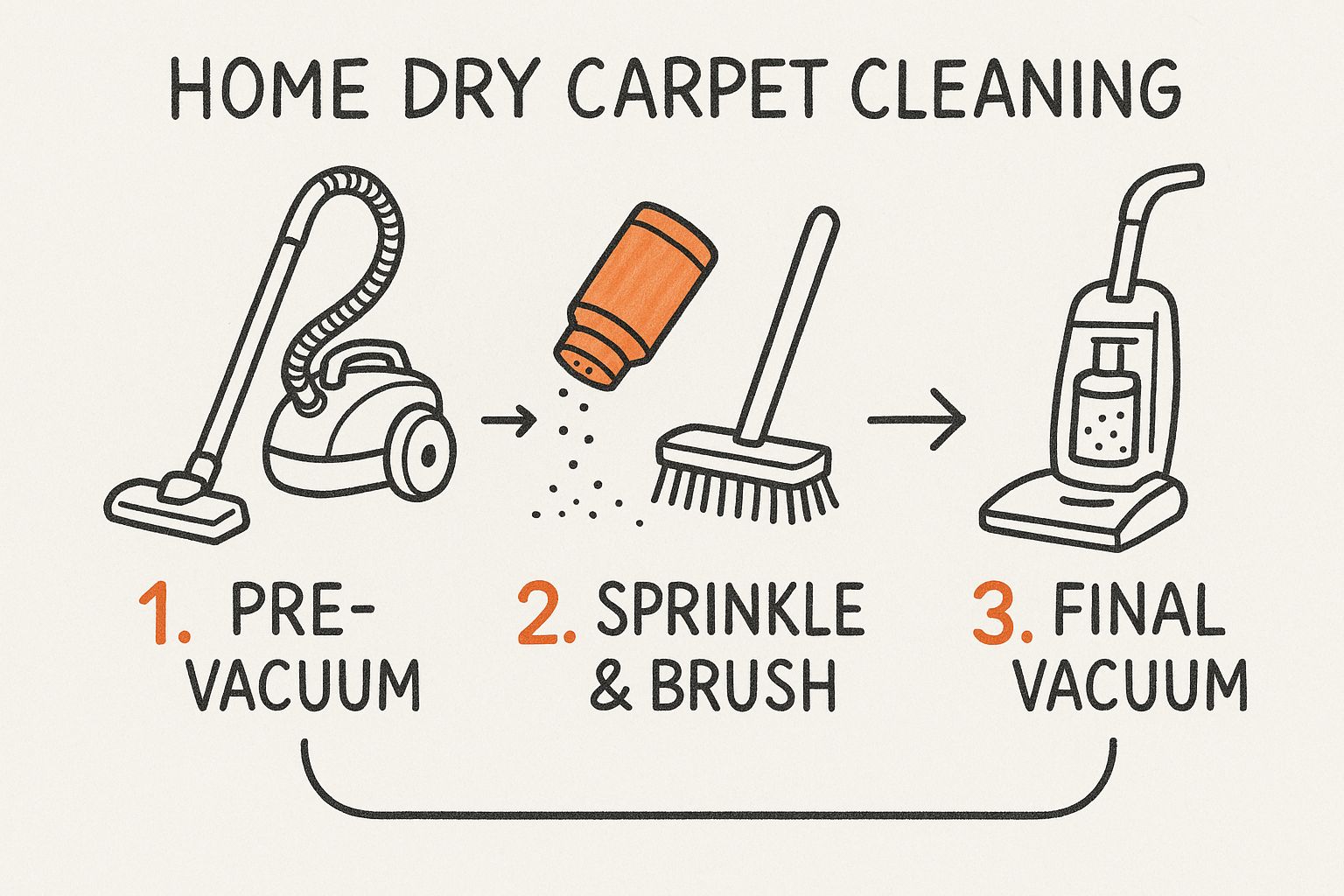
As you can see, it’s a cycle: get it ready, apply the product, and then remove it. Following these steps ensures you don't miss anything and get a really thorough clean.
Applying the Cleaning Compound
First things first, start sprinkling the powder evenly across a manageable section of your carpet. You're aiming for a light, consistent layer. Think dusting a cake with powdered sugar, not burying it in a snowdrift of flour. One of the biggest mistakes people make is over-applying, which just makes the vacuuming part a nightmare.
Once the powder is down, it’s time to work it into the fibers. Grab a medium-stiff carpet brush or a specialized machine and gently agitate the area. Use simple back-and-forth motions to make sure the granules get deep into the pile—that's where the most stubborn dirt loves to hide. This agitation step is critical because it maximizes the contact between the cleaning compound and all the trapped soil.
This method is gaining traction all over the globe. In fact, the Asia-Pacific region holds the largest share of the global net carpet cleaner market, at about 37.2%. That market is projected to hit a whopping USD 750.3 million by 2025, largely because people want cleaning methods that don't destroy their carpets. Dry methods are perfect for that. You can dig deeper into these trends in the net carpet cleaners market report.
Understanding Dwell Time
After you've brushed the compound in, the most important—and easiest—phase begins: dwell time. This is when you just let the powder sit there and work its magic. For you, it’s a break. For the powder, it’s go-time. It’s actively absorbing all the dissolved dirt, oils, and allergens from your carpet fibers.
The recommended dwell time is almost always printed right on the product packaging, usually somewhere between 15 to 30 minutes. Whatever you do, resist the urge to vacuum it up early. Cutting this time short means you're leaving dirt behind and basically wasting your effort.
During this waiting period, it's a good idea to keep pets and kids out of the room so they don't track the powder all over the house.
The Final Vacuum Pass
Once the dwell time is up, you get to the most satisfying part: vacuuming it all up. Grab a high-quality vacuum cleaner with really strong suction and go over the entire treated area. The goal here is to suck up every last particle of the cleaning powder along with all the grime it has soaked up.
Here are a few tips to make your final vacuum pass super effective:
- Go Slow: Don't rush it. A slow, deliberate pace lets the vacuum's brush roll agitate the fibers properly and gives the suction time to pull up all that fine powder.
- Switch Directions: Vacuum the area in multiple directions. Go north-to-south, then east-to-west. This helps lift particles from all sides of the carpet fibers.
- Check Your Bag or Canister: This powder is fine and will fill up your vacuum fast. Check it about halfway through and empty it if needed to keep your suction power at its max.
If you hit a spot and realize you went a little heavy on the powder, don't sweat it. Just go over that area a few extra times with the vacuum. The powerful suction will eventually lift the excess, leaving your carpet looking fresh, clean, and ready to walk on immediately.
Targeting Tough Stains with Dry Methods
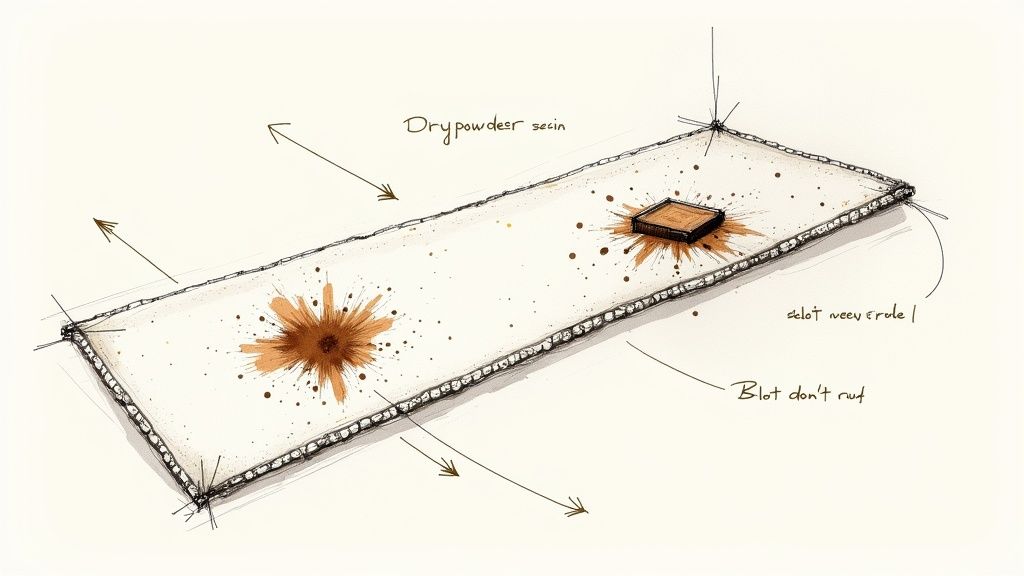
Spills are going to happen. It's just a part of life, but they don't have to become a permanent, ugly fixture on your floor. What you do in those first few minutes after an "oops" moment makes all the difference.
If you remember nothing else, remember this: blot, never rub.
Seriously. Grinding a fresh spill with a cloth just forces the stain deeper into the carpet fibers. It can even damage them, leaving a weird, fuzzy patch that looks worse than the original spot. Instead, grab a clean white cloth, press down firmly, and lift. Work from the outside of the spill toward the middle to keep it from spreading.
Once you've blotted up all the excess liquid you can, it's time to bring in your dry cleaning compound for some targeted treatment.
Handling Specific Everyday Spills
Different messes need slightly different tactics. The real magic of a dry cleaning powder is its ability to absorb and pull the rest of the staining agent out of the carpet fibers after you've dealt with the initial mess.
Here’s a quick rundown for some of the usual suspects:
- Coffee or Red Wine: After you've blotted like your life depends on it, sprinkle a good dry carpet powder right onto the damp spot. Give it at least 20-30 minutes to work its magic and soak up the discoloration, then vacuum it up thoroughly.
- Greasy Food Stains: For those oily spots from pizza or dropped butter, gently scrape up any solid bits first. Then, apply your powder and use a soft brush to work it into the greasy fibers. The powder bonds with the oil, making it easy to vacuum away.
- Pet Accidents: First, get rid of any solid waste and blot up as much liquid as you possibly can. Apply the powder over the area—if you can find one with antibacterial properties, even better. It'll help tackle the odors while it cleans.
Getting the fundamentals right is everything when it comes to stain removal. For a more detailed look, check out our guide on the best way to spot clean carpet for more strategies.
When Dry Powder Is Not Enough
Let's be real—sometimes a simple sprinkle of powder isn't going to cut it, especially if a stain has had time to dry and set in. For those more stubborn spots, you can kick things up a notch by making a paste.
Mix a little bit of your dry cleaning powder with a few drops of water—just enough to form a thick paste, like toothpaste. Apply this directly to the stain, let it dry completely, and then vacuum it away. This gives you a much more concentrated cleaning punch.
This paste method works surprisingly well on older, dried-on stains that have really bonded to the carpet fibers.
Just one word of caution: always test this paste on a hidden spot first (like inside a closet or under a sofa) to make sure it doesn't mess with your carpet's color. The whole point of dry cleaning carpet is to fix problems, not create new ones
When a Professional Touch Is Needed
DIY dry cleaning methods are fantastic for keeping your carpets looking fresh and tackling the occasional spill. I’m a big advocate for it. But let’s be honest, there are times when even the best home efforts just can’t compete with the power and precision of professional equipment.
Knowing when to throw in the towel and call for backup is the key to protecting your carpet's lifespan and your sanity.
Sometimes, a stain or a smell has worked its way so deep into the carpet padding that a surface treatment won’t even touch it. If you're looking at widespread water damage, stubborn pet odors that just keep coming back, or you're dealing with delicate antique rugs, it’s time to step away from the machine. These are the situations where a wrong move could cause permanent, costly damage.
Signs You Need an Expert
A true professional brings more than just a powerful vacuum to the job. They're using commercial-grade, low-moisture machines that agitate carpet fibers way more effectively and pull out encapsulated dirt with incredible force. This is a game-changer for that deep, set-in grime your household equipment simply leaves behind.
It might be time to call a pro if you notice:
- Widespread Discoloration: If you have large, "traffic pattern" areas that still look dull or dingy even after you've cleaned them.
- Lingering Odors: Smells from pets, smoke, or mildew that seem to be baked into the very fibers and padding of the carpet.
- Delicate Materials: You own wool, silk, or antique rugs. These can be easily ruined by the wrong pH levels or cleaning techniques.
A professional assessment can be the difference between restoring your carpet and having to replace it. An expert can identify the fiber type and the real cause of a stain, applying a targeted treatment that is both safe and powerful.
The Value of Professional Expertise
There's a reason the professional carpet cleaning industry is booming. Market research projects the global carpet cleaning services market will jump from USD 2.62 billion in 2024 to USD 3.93 billion by 2030. People are finally realizing how much clean carpets impact indoor air quality and how effective professional, eco-friendly solutions really are. You can check out more details about the carpet cleaning services market outlook.
Ultimately, investing in a professional service like Citrus Carpet Cleaning Buford isn't just about cleaning—it's about restoration. For those impossible situations where DIY methods just aren't cutting it, specialized tools and expertise can bring your floors back to life.
If you want to understand what's really involved, you can learn more about the benefits of deep carpet cleaning from seasoned experts. It ensures a healthier home and saves you a lot of money and headaches in the long run.
Still Have Questions About Dry Carpet Cleaning?
Let's clear the air on some of the most common things people ask about dry carpet cleaning. The world of carpet care has its share of myths, and getting straight answers can give you the confidence to decide if this low-moisture method is the right fit for your home. We'll tackle the big questions head-on.
One of the first things people wonder about is the name itself. It’s a little misleading, and I can see why it causes confusion.
Wait, Is It Actually Dry?
The term "dry cleaning" makes you think of a completely water-free process, but that's not the full picture. It's much more accurate to call it a "low-moisture" or "very-low-moisture" (VLM) cleaning method.
The specialized cleaning compounds we use aren't bone-dry; they contain a very small, controlled amount of moisture mixed with powerful cleaning agents.
This tiny bit of moisture is just enough to activate the ingredients, letting them effectively break down and absorb all that dirt, oil, and grime clinging to your carpet fibers. Unlike steam cleaning, which can dump gallons of water into your carpet, our method leaves your floors only slightly damp. You can walk on them almost immediately.
Is This Method Safe for My Specific Carpet?
This is a fantastic question because protecting your investment is priority one. The good news is that dry carpet cleaning is incredibly versatile and safe for the vast majority of carpet types you'll find in homes today.
It's especially perfect for delicate natural fibers that just can't handle being soaked with water. Things like:
- Wool Carpets: These are notorious for shrinking, browning, or having their colors bleed when they get over-saturated with traditional wet methods.
- Sisal and Jute Rugs: These plant-based fibers can easily warp or get permanent water stains if they get too wet, making a dry approach the only safe bet.
- Silk or Antique Rugs: Their delicate dyes and construction demand a gentle, low-moisture touch to prevent irreversible damage.
The method is also perfectly safe for common synthetic materials like nylon, polyester, and olefin, which make up a huge percentage of residential carpets. The gentle process helps maintain their texture and appearance without the harshness of other methods.
Still, it's always smart to check your carpet manufacturer's specific cleaning recommendations first. If you're ever in doubt, a quick spot test in an unseen area (like inside a closet) is a non-negotiable first step.
So, How Often Should I Dry Clean My Carpets?
There's no single right answer here; it really hinges on your household's lifestyle. Your daily habits, how many people live in the house, and whether you have pets play a huge role in how quickly dirt and allergens build up.
For a typical family home, a professional deep clean is recommended every 12 to 18 months. But this can change quite a bit based on what's happening in your house. Homes with pets, kids, or family members with allergies really benefit from a more frequent schedule.
Here’s a more tailored guide to help you figure it out:
| Household Type | Recommended Frequency | Key Considerations |
|---|---|---|
| Homes with Pets or Kids | Every 6-9 months | More effectively deals with tracked-in dirt, spills, and pet dander. |
| High-Traffic Households | Every 9-12 months | Focuses on main living areas, hallways, and entryways that see constant use. |
| Low-Traffic Homes | Every 12-18 months | A good schedule for households with fewer occupants and less daily foot traffic. |
Remember, your best defense between deep cleans is regular vacuuming—at least 2-3 times per week. It pulls up all that surface-level dirt before it has a chance to get ground deep into the carpet pile, which makes a huge difference in keeping your floors looking fresh.
When DIY isn't cutting it and you need a guaranteed deep clean without the long dry times, trust the experts. Citrus Carpet Cleaning Buford uses a proprietary citrus-based, low-moisture solution that leaves your carpets fresh, residue-free, and ready to enjoy in just a couple of hours. Get your free, no-obligation "EXACT-imate" today by visiting https://citruscarpetcleaningatlanta.com.
Article created using Outrank

